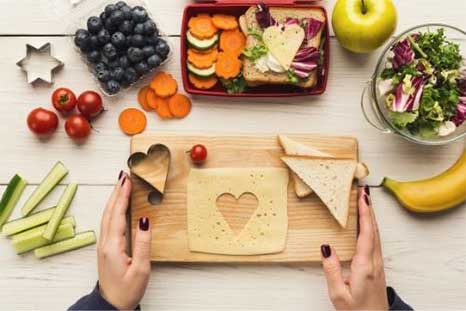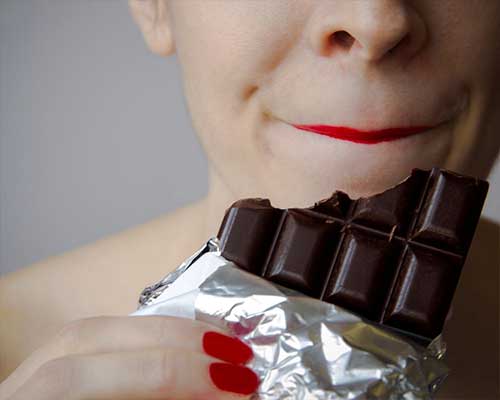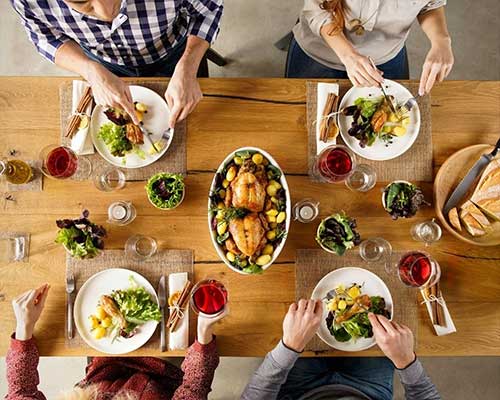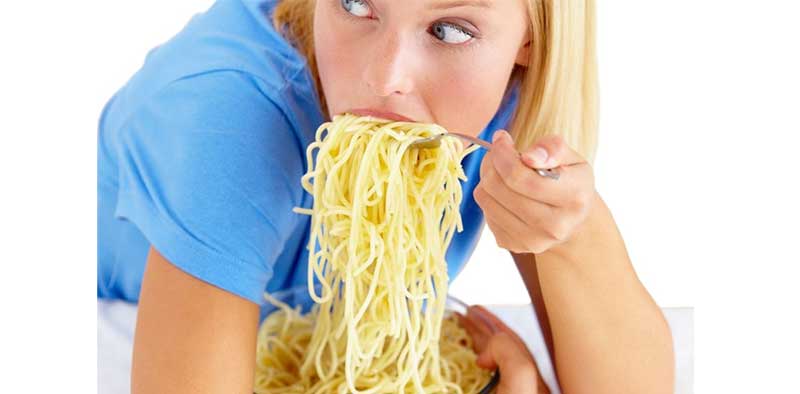This post is also available in:
 Español (Spanish)
Español (Spanish)
You get home from a hard day.. and you head directly to the fridge. That little voice in your head is asking for something to eat.. NOW. Before you know it, you’re eating, mindlessly snacking out of a packet or tupperware, and you end up feeling guilty, uncomfortable and a little bloated. If you weren’t hungry, why did you just eat so much?
Hunger and cravings are not the same. Physical hunger is a sign that your body needs nutrients.
Cravings are generally characterized by a drive to eat triggered by an emotion o repetitive thoughts about food. Cravings come from a mental need rather than a physical one.

Both feelings of being overly hungry or uncontrollable cravings get in the way of your healthy eating goals. Here are some ways to better manage cravings and get out of the cycle of food guilt.
How do you reduce cravings?
Cravings are impulsive feelings to eat- a tiny voice in your head that asks for a treat. For the most part, this is purely mental- cravings are not often associated with a physical need.
Cravings drive you to eat even when you aren’t hungry, or when your body isn’t in need of nutrients.. and they can appear for many reasons! Here are just a few..
- There’s food on display, like a candy bowl or a box of donuts.
- You smell something delicious, or you see something that looks particularly appetizing.
- You’re triggered by a memory- the taste of a particular food, or even by seeing a commercial for something to eat on TV.
- You are dealing with a difficult emotion or avoiding certain tasks, or are simply just bored.
However, it is important to note that cravings CAN be triggered by a need for certain nutrients- for example, a craving for tomatoes might indicate that your body is low on potassium. Your body has an incredible inner wisdom- but it can be hard to read the signs.
How to reduce cravings and recognize emotional hunger
If weight loss and managing cravings was simple, so many diets wouldn’t fail! It is important to really pay attention to your body, your eating habits, and your relationship with food to better understand how to manage food cravings. The main goal isn’t always eating less- its to eat in a way that promotes physical and emotional health- and reducing the dependence on food for emotional support! Here are some ways to tell the difference between emotional hunger/cravings and physical hunger:
Hunger:
- Can start to appear 2-3 hours after a main meal, although the timing can differentiate depending on the size and nutrient value of the meal!
- It’s not urgent- you can be hungry for a little while without feeling a sense of urgency.
- It comes on gradually, not all at once
- You’ll feel physical symptoms: growling stomach, emptiness in the stomach, headaches, irritability.. but these symptoms will diminish with food.
Cravings/emotional hunger:
- It appears all at once- even if you’ve just eaten.
- It feels urgent.
- It’s usually for a specific flavor or texture, like sweet, crunchy or salty.
- It might appear as a reaction to smelling something delicious, or hearing someone talk about a certain food, or as a reaction to an uncomfortable emotion or situation.
- It doesn’t go away, even when you’re physically full.

How to manage cravings and emotional hunger:
It might seem like your cravings will never go away, but there are some simple tips to keep in mind that can help you reduce them over time! It might feel frustrating to deal with cravings or like you are constantly struggling to stay on track- you are NOT alone in this! Here are some tips to help you to reduce cravings and start working on reducing emotional hunger:
Eat enough throughout the day (avoid restrictive diets!)
Eat well and eat enough. It may help for you to schedule your meals throughout the day, or plan ahead to make sure you have healthy options on hand. It can feel easy to ‘give in’ to cravings when you get home and there isn’t anything to eat! However, one of the biggest faults when aiming for weight loss is by eating too little- the answer to achieving what you want in your weight loss goals is NOT always to eat less. Make sure you are eating a variety of vegetables, fruit, lean proteins and other whole foods on a daily basis, and including treats in your diet on an occasional basis. Many cravings appear simply from having too many restrictions or from eating too few calories.
Don’t use food as a reward or a punishment
Food should not be a reward for an achievement, a hard day, or for doing something ‘good’. Try to find other ways to reward yourself for a job well done- a massage, getting your nails done, reading a good book, or heading out for a walk with a friend are all great alternatives.

Prioritize sleep
Sleep is a huge factor in reducing food cravings and managing stress- ideally, you would be getting between 7-8 hours of sleep a night. Bad or little sleep is associated with hormone dysregulation, problems with decision making, and high cortisol levels- leading to difficulty making healthy food decisions and problems regulating hunger signals. Read this blog post for some simple, effective ways to improve your sleeping habits!
Identify your triggers
When cravings pop up, they tend to be triggered by something- an event, an emotion, a memory, etc. Becoming aware of these triggers gives you power to either manage or avoid these situations more efficiently. You may notice that whenever you argue with your partner, you reach for the chips or crunchy, salty snacks- this is important information to bring awareness to your patterns and habits so you can prevent situations like this in the future, or work on breaking old habits and creating new ones.
Stop eating while distracted or multitasking
Have you ever sat down with a bowl of popcorn while watching Netflix, and without even realizing it, the popcorn is gone? If you consistently satisfy cravings while also doing something else or eat your meals while paying attention to the TV, phone or computer- it is likely you struggle to feel satisfied, which leads to more overeating. Try removing distractions while you eat, and committing to only doing ONE task at a time.

Start a better self care practice.
A good self care practice is one of the best ways to show yourself respect. We’re always in a hurry, dealing with different commitments and obligations, without much thought about what our needs are. A self care practice puts your needs ahead of others, and gives you time to truly connect with yourself.
Think about non food related activities that help you relax or contribute to your overall wellbeing, and start incorporating them into your routine. Self care should consist of activities that are truly just for YOU- not out of obligation to anyone else. For example, you might love to draw, read, paint, hike, sing, etc.
At the end of the day, cravings and emotional eating can be frustrating to deal with, but it is possible to overcome these issues! You may need some guidance in finding the best balance of nutrients and healthy habits for your lifestyle- and trust me, you are NOT alone in this! If you would like to discuss how to overcome your cravings and emotional eating habits and find balance in your nutrition- send me a message for your free discovery call!
This post is also available in:
 Español (Spanish)
Español (Spanish)


